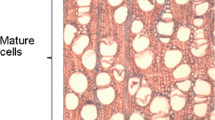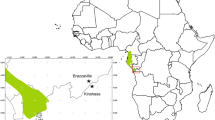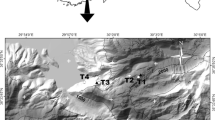Abstract
Key message
We demonstrate that tropical trees growing in wet climates can have a marked seasonality in cambium activity and stem growth associated with high temperature and day length of summer.
Abstract
Monitoring the rhythm of tree growth associated with the growth rings can contribute substantially to understanding forest dynamics and the management of tropical forests. In this study, we monitored the girth increment rhythm and described the wood characteristics (anatomy of growth rings, wood specific gravity) in 10 tropical tree species (103 individuals) naturally occurring in a wet and weakly seasonal region of Atlantic Forest in southern Brazil. We aimed to verify whether tree growth dynamics are associated with climate and woody anatomy in tropical trees with contrasting ecological characteristics. We installed permanent dendrometer bands and monthly assessed the girth increment for 22 months. We collected wood samples (non-destructive method), measured wood specific gravity and prepared permanent slides to characterize the growth ring markers. We found growth rings in all species (distinct in six species); deciduous species produced more distinguishable tree rings compared with semi-deciduous and evergreen tree species. Species varied in their accumulated girth growth (in average, from 1.83 to 62.64 mm), growth rates (1–15 %), and annual radial increment (0.16–5.44 mm). Girth increment was positively related to temperature and day length in five out of ten tree species, indicating the possible effects of these climatic variables in triggering cambial activity in these species. The growth pattern varied among species and was marginally associated to the tree deciduousness. We concluded that even in wet and less seasonal climates, there can be an association in the cambium activity and stem growth with the hotter and longer days of summer months.




Similar content being viewed by others
References
Alves ES, Angyalossy-Alfonso V (2000) Ecological trends in the wood anatomy of some Brazilian species. I: growth rings and vessels. IAWA J 21:3–30
Baas P, Vetter RE (1989) Growth rings in tropical trees. IAWA Bull 10(2):95–174
Baas P, Wheeler EA (2011) Wood anatomy and climate change. In: Hodkinson TR, Jones MB, Waldren S, Parnell JAN (eds) Climate change, ecology and systematics, Cambridge University Press, New York, pp 141–155
Billings WD (1952) The environment complex in relation to plant growth and distribution. Quart Rev Biol 27:251–265
Borgo M, Tiepolo G, Reginato M, Kuniyoshi YS, Galvão F, Capretz RL, Zwiener VP (2011) Espécies arbóreas de um trecho de Floresta Atlântica do Município de Antonina, Paraná, Brasil. Floresta 41:819–832
Botosso PC, Tomazello-Filho M (2001) Aplicação de faixas dendrométricas na dendrocronologia: avaliação da taxa e do ritmo de crescimento do tronco de árvores tropicais e subtropicais. In: Maia NB, Martos HL, Barella W (eds) Indicadores ambientais: conceitos e aplicações. EDUC, São Paulo, pp 145–17
Botosso PC, Vetter RE (1991) Alguns aspectos sobre a periodicidade e taxa de crescimento em 8 espécies arbóreas tropicais de floresta de Terra Firme (Amazônia). Rev Inst Florest 3:163–180
Botosso PC, Vetter RE, Tomazello-Filho M (2000) Periodicidade e taxa de crescimento de árvores de cedro (Cedrela odorata L., Meliaceae), jacareuba (Calophyllum angulare A.C. Smith, Clusiaceae) e muirapiranga (Eperua bijiga Mart. ex Benth, Leg. Caesalpinioideae) de floresta de terra firme, em Manaus-AM. In: Roig FA (ed) Dendrocronología en América Latina, Mendoza, pp 357–380
Boura A, De Franceschi D (2007) Is porous wood structure exclusive of deciduous trees? C R Palevol 6:385–391
Bruel BO, Marques MCM, Britez RM (2010) Survival and growth of tree species under two direct seedling planting systems. Rest Ecol 18:414–417
Callado CH, Neto SJS, Scarano FR, Costa CG (2001) Periodicity of growth rings in some flood-prone trees of the Atlantic Rain Forest in Rio de Janeiro, Brazil. Trees 15:492–497
Callado CH, Roig FA, Tomazello-Filho M, Barros CF (2013) Cambial growth periodicity studies of South American woody species—a review. IAWA J 34:213–230
Campos JCC (1970) Principais fatores do meio que afetam o crescimento das árvores. Floresta 2:45–52
Cardoso FCG, Marques R, Botosso PC, Marques MCM (2012) Stem growth and phenology of two tropical trees in contrasting soil conditions. Plant Soil 354:269–281
Chabot BF, Hicks DJ (1982) The ecology of leaf life spans. Ann Rev Ecol Syst 13:229–259
Chitra-Tarak R, Ruiz L, Pulla S, Dattaraja H, Suresh H, Sukumar R (2015) And yet it shrinks: a novel method for correcting bias in forest tree growth estimates caused by water-induced fluctuations. For Ecol Manag 336:129–136
Committee IAWA (1989) IAWA list of microscopic features for hardwood identification. IAWA Bull 10:219–332
Copenheaver CA, Pokorski EA, Currie JE, Abrams MD (2006) Causation of false ring formation in Pinus banksiana: a comparison of age, canopy class, climate and growth rate. For Ecol Manag 236:348–355
Cunningham S, Read J (2003) Comparison of temperate and tropical rainforest tree species: growth responses to temperature. J Biogeogr 30:143–153
David MD, Downes GM (2009) The use of precision dendrometers in research on daily stem size and wood property variation: a review. Dendrochronologia 27:159–172
Dié A, Kitin P, Kouamé FNG, Bulcke JV, Acker JV, Beeckman H (2012) Fluctuations of cambial activity in relation to precipitation result in annual rings and intra-annual growth zones of xylem and phloem in teak (Tectona grandis) in Ivory Coast. Ann Bot 110:861–873
Dünisch O, Bauch J, Gasparotto L (2002) Formation of increment zones and intra-annual growth dynamics in the xylem of Swietenia macrophylla, Carapa guianensis, and Cedrela odorata (Meliaceae). IAWA J 23:101–119
Escudero A, del Arco JM (1987) Ecological significance of the phenology of leaf abscission. Oikos 49:11–14
Fahn A, Burley J, Longman KA, Mariaux A (1981) Possible contributions of wood anatomy to the determination of the age of tropical trees. In: Bormann FH, Berlyn G (eds) Age and growth rate of tropical trees: new directions for research. Yale University, New Haven, pp 83–100
Ferretti AR, Britez RM (2006) Ecological restoration carbon sequestration and biodiversity conservation: the experience of the Society for Wildlife Research and Environmental Education (SPVS) in the Atlantic Rain Forest of Southern Brazil. J Nat Conserv 14:249–259
Givnish TJ (2002) Adaptive significance of evergreen vs. deciduous leaves: solving the triple paradox. Silva Fennica 36:703–743
Gourlay ID (1995) The definition of seasonal growth zones in some african Acacia species: a review. IAWA J 16(4):353–359
Heinrich I, Banks JCG (2005) Dendroclimatological potential of Australian red cedar. Aust J Bot 51:21–32
Jacoby GC (1989) Overview of tree-ring analysis in tropical regions. IAWA Bull 10:99–108
Jurik TW, Briggs GM, Gates DM (1988) Springtime recovery of photosynthetic activity of white pine in Michigan. Can J Bot 66:138–141
Kauano E, Torezan JMD, Cardoso FCG, Marques MCM (2012) Landscape structure in the northern coast of Parana State, a hotspot for the Brazilian Atlantic Forest conservation. Rev Árvore 36:961–970
Keeland B, Sharitz R (1993) Accuracy of tree growth measurements using dendrometer bands. Can J For Res 23:2454–2457
Kozlowski TT, Kramer PJ, Pallardy SG (1991) The physiological ecology of woody plants. Academic Press, California
Lamprecht H (1990) Silvicultura nos trópicos; Ecossistemas florestais e respectivas espécies arboreas: possibilidades e métodos de aproveitamento sustentado. Eschborn, Instituto de Silvicultura da Universidade de Gottingen, GTZ, p 130
Larson PR (1995) The vascular cambium. Springer Verlag, Berlin
Liebsch D, Goldenberg R, Marques MCM (2007) Florística e estrutura de comunidades vegetais em uma cronoseqüência de Floresta Atlântica no Estado do Paraná, Brasil. Acta Bot Bras 21:983–992
Liebsch D, Marques MCM, Goldenberg R (2008) How long does the Atlantic Rain Forest take to recover after a disturbance? Changes in species composition and ecological features during secondary succession. Biol Conserv 141:1717–1725
Lisi CS, Tomazello-Filho M, Botosso PC, Roig FA, Maria VRB, Ferreira-Fedele L, Voigt ARA (2008) Tree-ring formation, radial increment periodicity, and phenology of tree species from a seasonal semi-deciduous forest in southeast Brazil. IAWA J 29:189–207
Lopez L, Villalba R, Peña-Claros M (2012) Determining annual periodicity of growth rings in seven tree species of a tropical moist forest in Santa Cruz, Bolivia. For Syst 21:508–514
Lüttge U, Hertel B (2009) Diurnal and annual rhythms in trees. Trees 23:683–700
Marcati CR, Milanez CRD, Machado SR (2008) Seasonal development of secondary xylem and phloem in Schizolobium parahyba (Vell.) Blake (Leguminosae: caesalpinioideae). Trees 22:3–12
Maria VRB (2002) Estudo da periodicidade do crescimento, fenologia e relação com a atividade cambial de espécies arbóreas tropicais de florestas estacionais semideciduais. MSc Dissertation, Escola Superior de Agricultura “Luiz de Queiroz”, Piracicaba, University of São Paulo
Mariaux A (1969) La périodicité des cernes dans le bois de limba. Bois et Forêts des Tropiques No 128:39–54
Mariaux A (1970) La périodicité de formation des cernes dans le bois de L’okoume. Bois et Forêts des Tropiques No. 131:37–50
Mariaux A (1977) Marques et rubans dendroètres. Information Technique: 238, CTFT, Morgent-sur-Marne
Mariaux A (1995) Growth periodicity in tropical trees. IAWA J 16:327–328
Marques MCM, Oliveira PEAM (2004) Fenologia de espécies do dossel e do sub-bosque de duas Florestas de Restinga na Ilha do Mel, sul do Brasil. Rev Bras Bot 27:713–723
Marques MCM, Oliveira PEAM (2008) Seasonal rhythms of seed rain and seedling emergence in two tropical rain forests in southern Brazil. Plant Biol 10:596–603
Masiokas M, Villalba R (2004) Climatic significance of intra-annual bands in the wood of Nothofagus pumilio in southern Patagonia. Trees 18:696–704
Metcalfe CR, Chalk L (1950) Anatomy of the dicotyledons: leaves, stem and wood in relation to taxonomy with notes on economic uses. Clarendon Press, Oxford
Monk CD (1966) An ecological significance of evergreenness. Ecology 47:504–505
Mozeto AA, Fritz P, Moreira MZ, Vetter E, Aravena R, Salati E, Drimmie RJ (1988) Growth rates of natural Amazonian forest trees based on radiocarbon measurements. Radiocarbon 30:1–6
Muller-Landau HC (2004) Interspecific and inter-site variation in wood specific gravity of tropical trees. Biotropica 36:20–32
O’Brien TP, Feder N, Mccully ME (1965) Polychromatic staining of plant cell walls by toluidine blue O. Protoplasma 59:368–373
O’Brien JJ, Oberbauer SF, Clark DB, Clark DA (2008) Phenology and stem diameter increment in Costa Rica wet tropical forest. Biotropica 40:151–159
Parolin P, Ferreira LV, Junk WJ (1998) Central Amazonian floodplains: effect of two water types on the wood density of trees. Verh Internat Verein Limnol 26:1106–1112
Poole I, van Bergen PF (2006) Physiognomic and chemical characters in wood as palaeoclimate proxies. Plant Ecol 182:175–195
Priya PB, Bhat KM (1999) Influence of rainfall, irrigation and age on the growth periodicity and wood structure in teak (Tectona grandis). IAWA J 20(2):181–192
Roig FA (2000) Dendrocronología en los bosques del Neotrópico: revisión y prospección futura. In: Roig FA (ed) Dendrocronología en América Latina, Mendoza, pp 307–355
Shimamoto CY, Botosso PC, Marques MCMM (2014) How much carbon is sequestered during the restoration of tropical forests? Estimates from tree species in the Brazilian Atlantic forest. For Ecol Manag 329:1–9
Smith DM (1954) Maximum moisture content method for determining specific gravity of small wood samples. Laboratory report no. 2014. United States Department of Agriculture Forest Service, Forest Products, Madison and Wisconsin
Speer J (2010) Fundamentals of tree-ring research. The University of Arizona Press, Tucson, p 333
Stahle DW (1999) Useful strategies for the development of tropical tree-ring chronologies. IAWA J 20:249–253
Suzuki E (1999) Diversity in specific gravity and water content of wood among Bornean tropical rainforest trees. Ecol Res 14:211–224
Tomazello-Filho M, Lisi CS, Hansen N, Cury G (2004) Anatomical features of increment zones in different tree species in the state of São Paulo, Brazil. Sci Forestalis 66:46–55
van Gelder HA, Poorter L, Sterck FJ (2006) Wood mechanics, allometry, and life-history variation in a tropical rain forest tree community. New Phyt 171:367–378
Vetter RE (2000) Growth periodicity and age of Amazonian tree species. Methods for their determination. In: Roig FA (ed.), Dendrocronología en América Latina, Mendoza, pp 135–155
Vetter RE, Botosso PC (1989) Remarks on age and growth rate determination of Amazonian trees. IAWA Bull 10:133–145
Vogel JC, Fuls A, Visser E (2001) Radiocarbon adjustments to the dendrochronology of a yellowwood tree (Research Letters). S Afr J Sci 97:164–166
Walter H (1983) Vegetation of the earth. Spring-Verlag, Germany
Wheeler E (2011) Insidewood—a web resource for hardwood anatomy. IAWA J 32:199–211
Wheeler E, Baas P (1993) The potentials and limitations of dicotyledonous wood anatomy for climatic reconstructions. Paleobiology 19:487–498
Wimmer R, Strumia G, Holawe F (2000) use false rings in Austrian pine to reconstruct the early growing season precipitation. Can J For Res 30:1691–1697
Worbes M (1989) Growth rings, increment and age of trees in inundation forests, savannas and a mountain forest in the Neotropics. IAWA Bull 10:109–122
Worbes M (1995) How to measure growth dynamics in tropical trees: a review. IAWA J 16:337–351
Worbes M (1999) Annual growth rings, rainfall-dependent growth and long-term growth patterns of tropical trees from the Caparo Forest Reserve in Venezuela. J Ecol 87:391–403
Worbes M (2002) One hundred years of tree-ring research in the tropics—a brief history and an outlook to future challenges. Dendrochronologia 20:217–231
Worbes M, Staschel R, Roloff A, Junk WJ (2003) Tree ring analysis reveals age structure, dynamics and wood production of a natural forest stand in Cameroon. For Ecol Manag 173:105–123
Zanne AE, Lopez-Gonzalez G, Coomes DA, Ilic J, Jansen S, Lewis SL, Miller RB, Swenson NG, Wiemann MC, Chave J (2013) Global wood density database 2009. http://hdl.handle.net/10255/dryad.235. Accessed 8 Feb 2013
Zar JH (1999) Biostatistical analysis. Prentice-Hall, New Jersey
Zimmerman JK, Everham EM III, Waide RB, Lodge DJ, Taylor CM, Brokaw NVL (1994) Responses of tree species to hurricane winds in subtropical wet forest in Puerto Rico: implications for tropical tree life histories. J Ecol 82:911–922
Acknowledgments
We thank Juliano Morales de Oliveira, Marcelo Errera, Isabela Galarda Varassin for their suggestions to the first version of the manuscript and to Gabriel A.R. de Paula for support with part of the analysis. We also thank the Brazilian Education Council (Capes/Reuni) for the fellowship to CYS and the Brazilian Agriculture Research Company (Embrapa Floresta) and the NGO Sociedade de Pesquisa em Vida Selvagem e Educação Ambiental (SPVS) for their support and staff assistance during the field work. MCMM received grants from the Brazilian Research Council (CNPq, Grants 304650/2012-9 and 229349-2013-7).
Author information
Authors and Affiliations
Corresponding author
Ethics declarations
Conflict of interest
The authors declare no conflicts of interest.
Additional information
Communicated by G. Piovesan.
Rights and permissions
About this article
Cite this article
Shimamoto, C.Y., Botosso, P.C., Amano, E. et al. Stem growth rhythms in trees of a tropical rainforest in Southern Brazil. Trees 30, 99–111 (2016). https://doi.org/10.1007/s00468-015-1279-z
Received:
Revised:
Accepted:
Published:
Issue Date:
DOI: https://doi.org/10.1007/s00468-015-1279-z




